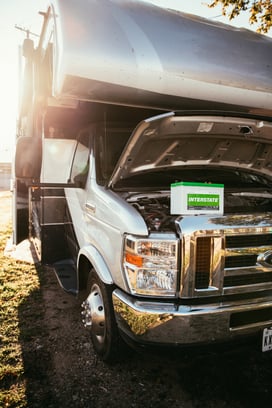
When it comes to recreational vehicles, the journey is just as important as the destination. So, whether parked at a remote campsite or cruising down the highway, a dependable RV battery impacts the functionality, safety and overall enjoyment of your RVing experience.

A dependable RV battery powers critical systems such as lights, water pumps, heating and cooling, appliances, entertainment systems, navigation devices and control panels. RV batteries are also crucial for safety systems like smoke detectors, carbon monoxide detectors and emergency lighting.
Knowing you have a dependable battery onboard, like an Interstate® RV battery, provides peace of mind so you can focus on enjoying your RV adventures without worrying about power-related issues.
Find an Interstate Battery for your RV here.
As the frost thaws and the allure of outdoor adventures call, it's time to breathe life back into your RV by preparing it for the season. An RV battery must be de-winterized to be used after winter storage. Here's a summary of the steps to take:
- Ensure you're in a well-ventilated area and wearing appropriate safety gear, such as gloves and safety goggles, before starting.
- Inspect the battery for any visible damage, corrosion or leaks. If you notice any issues, address them before proceeding.
- If the battery's charge level has dropped significantly during winter storage, connect the battery to a charger. Follow the charging instructions and ensure you're using the appropriate charging settings.
- For flooded lead-acid batteries, check the electrolyte levels in each cell. If the levels are low, add distilled water to bring them to the recommended level. Be sure to avoid overfilling.
- Over time, corrosion can build up on battery terminals and cables. Clean these areas using a mixture of baking soda and water or a commercial battery terminal cleaner. Scrub gently with a wire brush or battery terminal cleaner tool.
- Check the battery cables for any signs of damage, fraying or corrosion. Replace damaged cables as needed.
- After charging and reconnecting, test the voltage using a voltmeter.
- To ensure the battery's performance, consider conducting a load test. This test assesses how well the battery can deliver power under a load. If the battery fails the load test, it might be time for a replacement.

Monitor its performance once the battery is de-winterized and back in use. Check for any signs of power loss, rapid discharge or other anomalies indicating battery issues.
Remember that the steps above can vary depending on the type of battery and the battery provider’s recommendations. Refer to your RV's owner’s manual and the battery maintenance guide for the most accurate instructions.
If you need clarification or help with any step mentioned above, contact Campers Inn to schedule an appointment.
How to Replace an RV Battery
Whether reinstalling an existing battery or setting up a new one, understanding the steps involved ensures a safe and successful installation.
- Make sure you're in a well-ventilated area and wearing appropriate safety gear, such as gloves and safety goggles.
- Select a battery compatible with your RV's electrical system and meets your power requirements.
- Find your RV's designated battery compartment or area where the new battery will be installed.
- Clear any debris and ensure the battery compartment or area is clean and dry.
- If your RV is connected to power or has any electrical devices running, disconnect them to guarantee safety during the installation.
- Place the new battery in the designated compartment, ensuring it's secure and won't shift during travel.
Don't hesitate to contact Campers Inn for more on RV battery parts and service.

Connecting the Cables
Positive Terminal
Connect the battery's positive (+) terminal to the positive cable. This cable is often red.
Negative Terminal
Connect the battery's negative (-) terminal to the negative cable. This cable is often black.
To be sure, consult the owner's manual for your RV.
You can also ensure the cable connections are tight and secured to prevent accidental disconnection while on the road.
You may also cover the battery terminals with terminal protectors or spray to prevent corrosion and place a battery mat or non-conductive material underneath the battery to minimize vibration.
*Disclaimer: This information was provided by our partners at Interstate Battery.


